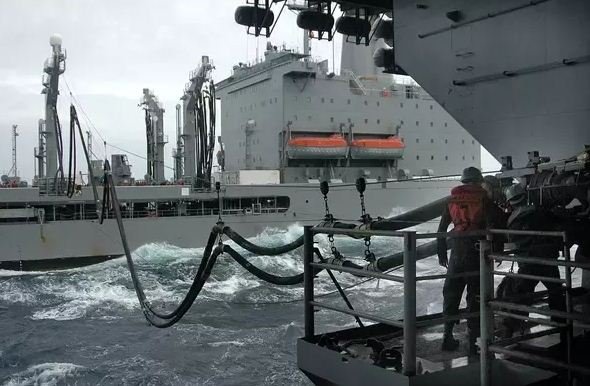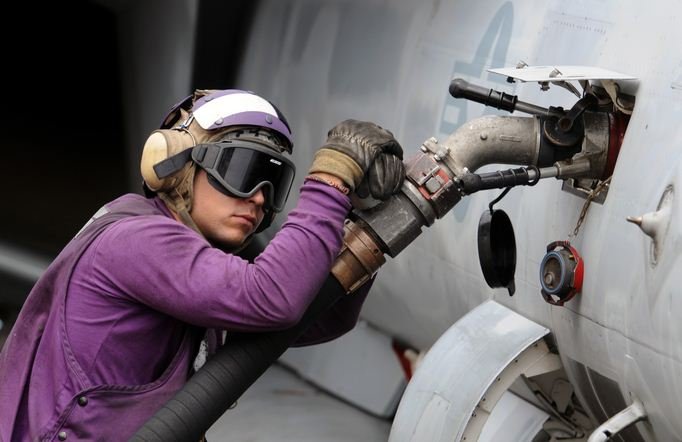How long could you survive without docking or restocking?
I was at Sea for 89 Days with a group of Ships anchored by the USS Enterprise,crossed the Atlantic & circled off Cyprus.
The only limited I saw was anger by personnel.
Solution,Boxing Smokers , legal gambling & r meals per day
You get a beer day when you have been at sea for six weeks. During my 30 months on a carrier we had a couple of beer days. Usually, while on deployment, your at sea periods are broken up with port calls, so beer days are unusual. (I am NOT in that picture).
The only reasonable answer to the question is to address the limiting factor on sustainment … and that is the aviation fuel.
During heavy optempo while we were in the vicinity of the Persian Gulf, we routinely replenished every three days. We could probably go somewhat longer but, just like with your car, it is smart to keep your tanks topped up.
It was intended to replace three types of supply ships: the AF (Store Ship), AKS (Stores Issue Ship), and AVS (Aviation Supply Ship).If a aircraft carrier needed parts to repair aircraft, or replace any damaged or worn part of the ship, my ship provided the parts. It also provided the ammo, and fuel for the aircraft on the carrier.
It also provided food, and general stores as well. An aircraft carrier in action burns through supplies in a hurry, and would run out in less than two weeks if not supported. Food would be the first one, followed shortly with AV gas. Even the nuclear power plant requires new parts constantly to stay in safe operation.
A Nuclear Powered Aircraft Carrier can sustain about 15-20 Years of operations without need for refueling.
The storage capacity of Nimitz Class carriers for refrigerated and dry food can support a crew of 6000 for Aproximatly 70 days.
But, the carrier's mission is to support Aircraft, not just sail around and feed the crew:
So normally, the Carriers are outfitted with 90 days of aviation and power plant related spare parts and has onboard repair capability for most all of high failure aviation components.
Additionally, Nimitz Class Carriers can carry a max load of 3.3M gallons of JP-5 jet fuel and average 2.6M Gallons onboard (with peacetime replenishments).
However, the embarked Air Wing (50-60 Aircraft) can go through the average Nimitz class Carrier's JP-5 storage capacity in about a week at nomal peacetime training sortie (cycles).
So, in short, as a war fighting machine, nuclear powered aircraft carriers need, at a minimum, to be replenished with JP-5 Jet Fuel on a weekly basis to maintain operational capability
Of course, I didn't include the ordinance spend rate in a war time scenario which should be addressed as far as periodical replenishment needs.
by @Ernest W. Adams
I suspect the answer to that is classified. I believe that they can make fresh water pretty well indefinitely using their nuclear reactors (unless there are disposable filters that need to be changed). But Nimitz-class carriers have a crew complement of as many as 5000. That's a lot of people to feed every day. Typically carriers travel in strike groups accompanied by a number of other ships, some of which are responsible for resupply, and come and go as necessary. If I had to guess, I would say a few weeks for the food, but that could be laughably wrong.
By @Scott Hays
Originally Answered: How long can a US carrier operate at sea without being resupplied?
It’s a hard questions to answer. If they are operating under the assumption that they are going to be out to sea with the idea that they will not be re-supplied for an extended period of time, and they watch what they are doing with food, etc… if I’m not mistaken they might be able to last for about 4–6 months. However, that is a stretch. Between ships compliment and air crew you are looking at over 5000 people.
By @Dan Gall
US Carriers have nuclear reactors, so power is always going to be available. But food doesn’t depend on power. You have to store food (including items you can turn into food like flour) beforehand.
Another consideration is fuel for your aircraft that you have onboard. Without fuel for them you are simply a big hole in the water with maybe 5000 mouths to feed.
A lot depends on what your sailors are accustomed to as well. On most US Carriers these days, fresh milk and meat is flown in from time to time if the carrier runs low. Some things can be stored frozen, others cannot. If pushed, with some shortfalls, a Carrier itself could last perhaps six months tops with no resupply but you would have a bunch of disgruntled sailors at the end.
But the US Navy has an efficient supply chain and usually can resupply you in drips and drabs using aircraft for a time.
By @Doug Hanchard
It would depend on operational tempo and threat status. An aircraft carrier is never sortied without replenishment support - ever. So the question is moot. U.S. Naval Policy does not allow an aircraft carrier to deploy without support services at sea. Ever. Any Admiral that did would be asked to walk the plank.
A Carrier Strike Group consists of fleet oilers and supply cargo aircraft (COD's) that can deliver anything the carrier needs including food and weapons. If its support ships are destroyed, the carrier may or may not continue. It's up to Command to determine if the supporting ships can be replaced in time before the carrier would be forced to withdraw from the zone of operations. Nimitz class aircraft carriers can operate continuously non-combat operations without resupply for a minimum of 90 days. If World War III broke out, the limiting factor before replenishing is usually fuel, weapons and spares for the aircraft. Even so, there are procedures that can extend the amount of time at sea including refueling aircraft in the air rather than filling up 100% on board.
The U.S. Navy has numerous scenarios it prepares for including extended periods at sea. During the two Gulf Wars, the US Navy only withdrew aircraft carriers for scheduled maintenance (rotation) and not replenishment factors. Nimitz Carrier USS Theodore Roosevelt fulfilled every mission asked of it, not once delayed by supplies. The five conventional powered carriers, Midway, Saratoga, America, Ranger, Kitty Hawk and John F Kennedy were never taken out of combat rotation because of supply issues. The U.S.S. Midway was on station, November of 1990 and did not leave the area until March the following year for rotation to the Philippines.@honey.bee
By @Samuel Scott
20 years on the nuclear generator(s) give or take a few years depending on what it is doing 50 to 100 days (on rations for 100 days) for the crew's food Jet fuel would last between 7 and 12ish days
Plane parts would last a big range because every crew has different conditions so so do the air craft and some aircraft are damaged easier than others and vice versa in different conditions such as weather, etc.
by @Matthew Heminger
You got Doug's technical answer...mine is simpler. It depends on how long the ship's systems hold up or can be repaired with supplied parts. I am assuming you would refresh the crew via air or sea transfer, bring in new supplies via air and ship to ship replenishment. If it had no operational requirements and could count on frequent resupply via air and sea then a nuclear carrier might be able to stay between ports for as long as 40-50 years. Now of course that isn't ever going to happen but like many questions in Quora (who would win between a Bengal Tiger and a Japanese Samurai) it is a very ambiguous hypothetical. @elias-jaxon
By @Stuart Ing
it all comes down to food, fuel for the planes or ammo. One of those will be the limiting factor. The ship itself could stay out until the reactor ran out of fuel, which would be measured in decades/centuries
@bobmaria57
By @Anthony Lawson
Food replenishment is the limitation ALL USA carriers operate on Nuclear power.




Hi! I am a robot. I just upvoted you! I found similar content that readers might be interested in:
https://www.quora.com/How-long-could-a-U-S-aircraft-carrier-sustain-itself
This is a major and admirable operation.